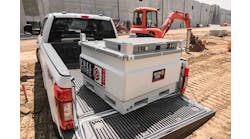April Construction Employment Tops February 2020 Level in 32 States, AGC Reports
Seasonally adjusted construction employment in April topped the February 2020 level in 32 states, lagged in 17 states and the District of Columbia, and was flat in Alaska, according to Associated General Contractors’ analysis of Bureau of Labor Statistics data posted this week. February 2020 was the month in which employment peaked nationally before plunging during widespread shutdowns in March and April 2020. Utah added the most construction jobs since February 2020 (16,300 jobs, 14.3 percent), followed by Florida (15,500, 2.7 percent) and Tennessee (13,200, 10 percent.) Utah had the largest percentage gain, followed by Montana (13.3 percent, 4,100 jobs) and South Dakota (12.5 percent, 3,000 jobs). New York shed the most construction jobs over 26 months (-27,700 jobs, -6.8 percent), followed by Pennsylvania (-15,600, -5.8 percent) and Texas.
The largest percentage losses were in New York, Kentucky (-6.2 percent, -5,000 jobs) and Pennsylvania. For the month, 27 states and D.C. added construction jobs, 21 states lost jobs and there was no change in Alaska and Rhode Island. Florida added the most construction jobs (4,300 jobs, 0.7 percent) followed by Texas (3,600, 0.5 percent) and Ohio (3,300, 1.4 percent).
Delaware had the largest percentage gain (2.1 percent, 500 jobs), followed by South Dakota (1.5 percent, 400 job), Ohio and Montana (1.4 percent, 500 jobs.) California lost the most last month (-13,200 jobs, 1.4 percent), followed by North Carolina (-5,900, 2,400 jobs.) Arkansas had the largest percentage loss (-2.7 percent, 1,500 jobs), followed by North Carolina and Kentucky (-2.1 percent, -1,600 jobs). BLS reports combined totals for mining, logging and construction in D.C., Delaware and Hawaii. Because there are few, if any, mining or logging jobs in these locations, AGC treats the levels and changes as solely construction employment.
Materials prices and availability have been mixed recently. Wire mesh pricing remains flat from April. The availability of wire mesh has begun to improve, with lead times being quoted in weeks instead of months. Lumber remains on the low side of the market in the month of May.
Big city population declines
“Big city population declines deepened across the U.S. last year as the pandemic continued sending Americans in search of more space,” the Wall Street Journal reported, citing a new Census Bureau release. “The largest cities lost a greater share of residents than small- and midsize cities during the year that ended July 1, 2021, new estimates show. Collectively in the nine cities with more than 1 million people, the population fell 1.7 percent, a loss of 419,000 residents. Only two cities in that group grew: Phoenix and San Antonio.
“New York, the nation’s largest city, lost 3.5 percent of its residents, about 305,000 people. The second-largest city, Los Angeles, lost 1 percent, or 41,000 people, while the third-largest, Chicago, lost 1.6 percent, or 45,000 people. San Francisco’s population fell 6.3 percent, a loss of 55,000 people. It and Chicago have lost so many people that their populations have fallen close to their 2010 levels. Several large cities that had logged gains in recent years saw losses, including Denver, Nashville, Tenn., Seattle and Atlanta. The nation’s midsize cities, those with populations of 500,000 up to 1 million, also had their populations edge down. Together, they declined 0.7 percent, losing 148,000 people. The group includes 28 cities, with San Jose, Calif., the biggest and Kansas City, Mo., the smallest. Twelve of the 28 in the group grew last year. Cities with fewer than a half-million people in effect saw flat growth. The group that ranges from 250,000 to 500,000 residents collectively lost 0.1 percent of the population, while those with 100,000 up to 250,00 people together grew 0.1 percent. Eight of the 15 fastest-growing large cities or towns by percent change were in the West (five in Arizona) and seven in the South. The South and West also contained the top 15 cities with the largest numeric gains (11 and four respectively.)”
Warehouse construction may be declining
In a sign that demand for warehouse construction may cool, Amazon “is seeking to sublease a minimum of 10 million square feet of warehouse space and is also exploring options to end or renegotiate leases with outside warehouse owners, according to a person familiar with the matter,” the Journal reported. “While Amazon is still determining exactly how much space to vacate, the amount is expected to be at least 10 million square feet, though it could eventually double or triple that. The company has more space than it needs in some of its largest markets, including New York, New Jersey, California and Atlanta.”






